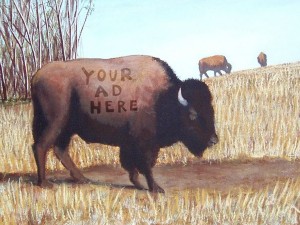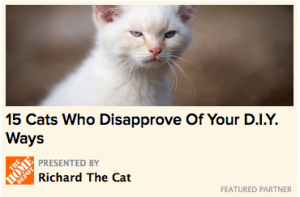 You’ve probably heard the term ‘native advertising’ over the last few weeks or months, but what exactly is it? Well, tell me if this scene sounds familiar:
You’ve probably heard the term ‘native advertising’ over the last few weeks or months, but what exactly is it? Well, tell me if this scene sounds familiar:
You’re absentmindedly clicking your way through the many “compelling” articles on BuzzFeed. Eva Longoria has a master’s degree. “Gee, that’s great!” you think. Aziz Ansari is talking about dating. “Man, I love that guy!” There’s an article on comic books and the job search. “Hmm…”
And then this:

It looks just like every other article on BuzzFeed – except for that Home Depot icon at the bottom left.
What’s Home Depot doing here?
Home Depot, my friends, is doing native advertising.
A Definition of Native Advertising
Native advertising is purchased (or “sponsored”) content for a highly specific demographic that acts like natural, unpaid content. In other words, native advertising is supposed to look as if it belongs on a website, in a magazine, or on TV with all of the non-advertorial content.
Clearly, marketers love native advertising because users engage with it in the same voluntary way that they engage with other articles, apps, and pieces of content. Sometimes, a user may not even consciously be aware of the fact that they’re engaging with native advertising.
Take the Juicy Fruit Sweet Talk app, for example. Nobody downloads this app because they like Juicy Fruit or want to be associated with the brand. People download the app because it’s funny. It fits in with the user and the user’s lifestyle.
Meanwhile, Juicy Fruit gets a ton of brand impressions and becomes – more or less subconsciously – viewed as a hip, young brand. That’s native advertising.
How Is Native Advertising Different From Content Marketing?
Okay, but what makes native advertising different from content marketing? Native advertising is a type of content marketing. Rebecca Lieb of the Altimeter Group explains it this way: “Native advertising lies somewhere in bridging the divide between content marketing (a pull strategy) and plain, old fashioned advertising, which is interruptive.”
Content marketing pulls.
Traditional advertising pushes.
Native advertising pulls in a push setting.
Should You Buy Native Advertising?
Of course, the questions now are: Should you buy native advertising? Should you create native advertising? While studies show that native ads outperform traditional banner ads, the margin between the two is slim. However, viewers did show 18% more purchase intent after viewing a native ad, compared to a traditional ad.
Relative to traditional advertising, native advertising is still in the infancy stage. There currently aren’t any reliable performance benchmarks to demonstrate native advertising’s value and worth, even though it intuitively would seem to be more valuable than traditional advertising.
As traditional banner ad click-through rates continue to plummet (just 0.2% click-through in 2012), it’s likely that native advertising – in banner and non-banner form – will be getting more attention from many marketing agencies.
More Examples of Native Advertising
For more examples of native advertising, look for sponsored (or “Presented By”) articles on websites like Gawker, Cracked, and BuzzFeed.
Also, check out these native advertising machines:
The Huffington Post (via AdAge)
What’s your take on native advertising? Will you create native advertising for your brand this year? Is this all just another way of saying branding and ‘content marketing’?